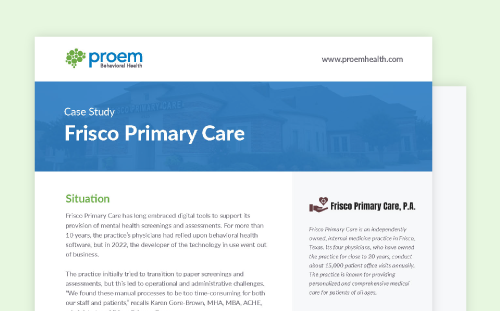
Evidence is mounting that providing behavioral health services in primary care settings increases access to care, leads to faster time to diagnosis, and provides more effective treatment. Many of the benefits of integrated behavioral health care come from patients receiving additional support from a trusted provider without the stigma of seeking care from a standalone behavioral health setting.
Though the concept is straightforward, the terminology is quite nuanced — and it can present a steep learning curve to practices looking to move beyond traditional models of care. Here, we explain the Collaborative Care Model, collaborative care management, integrated behavioral health and behavioral health integration (BHI) in the context of taking a whole person approach to mental health services.
1. What is the difference between integrated care and collaborative care?
In simple terms, one is a concept, and the other is a framework. Integrated care is the practice of providing care for medical and behavioral health conditions in one setting. According to the American Psychological Association, this occurs in concert with psychologists, who may “work alongside physicians as colleagues and team members in hospitals, primary care settings and other specialty health care practices.”
Meanwhile, the American Psychiatric Association describes collaborative care as a model for implementing care plans based on evidence-based guidelines for behavioral health treatment, coupled with “consistent principles of chronic care delivery, and attention to accountability and quality improvement.” This recognizes that up to 75% of patients with a diagnosed behavioral health condition also have at least one medical condition and often need additional assistance to manage these conditions simultaneously.
2. The Collaborative Care Model in primary care has five core principles.
More than a decade ago, industry stakeholders convened to draft the Collaborative Care Model as a framework for implementing integrated behavioral health. The framework has five principles, each of which needs to be in place.
-
Patient-centered team care
that emphasizes increased patient engagement and a care plan incorporating primary care and behavioral health goals. -
Population-based care
focused on a specific group of patients, with behavioral health professionals providing in-depth consultations instead of generic advice. -
Measurement-based treatment to target
specific goals and clinical outcomes that are routinely measured and changed if improvement isn’t happening. -
Evidence-based care
that includes medications as well as psychotherapies such as problem-solving treatment and cognitive behavior therapy. -
Accountable care
as reflected in a value-based reimbursement model, which emphasizes the quality of care and clinical outcomes instead of the volume of services provided.
3. There’s also a difference between integrated behavioral health and behavioral health integration.
Integrated care can go by a few different names. Among other terms, the Agency for Healthcare and Research Quality also refers to it as primary care behavioral health and integrated behavioral health.
It’s worth noting that behavioral health integration is different. Again, it’s subtle. BHI specifically refers to a set of services defined by the Centers for Medicare & Medicaid Services that primary care physicians can be reimbursed for providing. CMS approved payment for these services in 2017 to encourage practices to offer integrated behavioral health services and advance the whole-person model of treating mental health and clinical health in tandem.
4. If that’s not enough, there’s also Collaborative Care Management.
General BHI services are billed under a single Current Procedural Terminology (CPT) code (CPT 99484). These services can include conducting initial assessments and coordinating treatment. According to the American Academy of Family Physicians, practitioners without specialized behavioral health training may perform these services.
Under CMS rules, there’s also a set of CPT codes for Collaborative Care Management. These services are performed by a psychiatric consultant or a designated behavioral health care manager. They include joint care planning, caseload review, evidence-based intervention and patient follow-up using a validated ratings scale.
Collaborative Care Management is distinctive of the Collaborative Care Model (though both may be abbreviated as CCM or CoCM, at the risk of further confusion). CMS introduced the billing codes several years after the Collaborative Care Model framework was introduced. In other words, a practice may adopt the framework without using the Collaborative Care Management billing codes.
5. Integrated care and collaborative care aren’t interchangeable.
The American Psychological Association suggests that integrated care “involves the highest degree of collaboration and communication,” adding that “[p]sychologists are official members of the team and often share” a common electronic health record (EHR) system. In coordinated care, on the other hand, psychologists retain a degree of autonomy and address a patient’s behavioral health needs through referrals and consultations.
An FAQ from the American Psychiatry Association about reimbursement criteria for Collaborative Care Management (CCM) billing codes notes three additional distinctions:
- CCM care planning covers all health issues, while BHI focuses on more systematic care management of behavioral health.
- CCM requires the use of certified EHR technology, while BHI doesn’t.
- BHI services are provided solely by the billing practitioner, while it’s expected that a team of practitioners deliver services covered under CCM billing codes.
6. The Collaborative Care Model is an attractive option for Medicaid Health Homes.
Under the Affordable Care Act, states have the option to create Health Homes to help Medicaid beneficiaries manage chronic conditions. A “serious and persistent mental health condition” is one of three eligibility criteria for participation, and available services should include comprehensive care management and care coordination.
A research brief from the Center for Health Care Strategies suggests the Collaborative Care Model’s whole-person care focus is a good fit for the Medicaid Health Homes model. A review of the results of more than 70 clinical trials, this paper shows the Collaborative Care Model “demonstrate[s] higher effectiveness than usual care,” with “only a relatively small fraction of patients” needing referrals to specialty care. Additionally, the Collaborative Care Model generated savings in pharmacy, inpatient, outpatient, and mental health specialty care – to the tune of $6.50 saved for every $1 spent.
7. The Collaborative Care Model is effective in treating behavioral health in diverse patient populations.
The Center for Health Care Strategies further notes providing the Collaborative Care Model in primary care positively impacts various populations, including but not limited to adolescents, patients with cancer, ethnic minority groups and patients with diabetes. Similarly, a 2022 paper in Medicine points to the benefits of bringing the Collaborative Care Model to women’s health, geriatric health, and even college campuses – all sites of care where a patient is likely to seek care without feeling the same stigma often attached to behavioral health.
Many terms can refer to what happens when behavioral health is available through primary care. Practices can take different approaches to implementation and billing as well. The common thread, however, is a coordinated and evidence-based approach to the whole person care model that carefully tracks how patients are progressing, makes informed decisions about how treatment should proceed and improves outcomes while lowering the cost of care.
To find out more about how the Proem workflow solution can support the delivery of BHI, book a meeting.
* CPT is provided "as is" without warranty of any kind, either expressed or implied, including but not limited to, the implied warranties of merchantability and fitness for a particular purpose. No fee schedules, basic unit, relative values or related listings are included in CPT. The AMA does not directly or indirectly practice medicine or dispense medical services. The responsibility for the content of this file/product is with Proem and no endorsement by the AMA is intended or implied.





.png)









